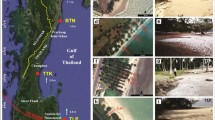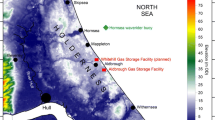Abstract
Major earthquake uplifts in south-central Alaska of marine deltaic surfaces to an inter-tidal or supra-tidal status cause drastic shifts in processes and vegetation. To assess long-term ecosystem changes as a deltaic landscape converted from a tidal marsh to a supra-tidal wetland, we studied a four-stage chronosequence of deltaic surfaces (30-yr-old inter-tidal surface, 352-yr-old inter-tidal surface, 30-yr-old supra-tidal surface, and 280-yr-old supra-tidal surface). Plots were used to gather landform, soils, and vegetation information, and landform schematics and aerial photo interpretation were used to determine their spatial distribution. Succession progressed on inter-tidal surfaces from pioneer species (principallyCarex lyngbyaei) on newly uplifted mud flats, to a mature tidal marsh with channels, levees, and basins dominated byCarex lyngbyaei with thick root mats. Uplift of the mature tidal surface to a supra-tidal status allowed freshwater tolerant species (Equisetum fluviatile, Sphagnum spp.) to invade the basins, and trees and shrubs displaced herbaceous vegetation on levees. On the oldest supra-tidal surface, basins developed peatlands (Andromeda polifolia, Sphagnum spp.), and pH decreased. Levees supported trees or shrubs on mineral or peat soils. Vegetation zonation within a basin-levee complex was evident and repeated, with some variation, across the surfaces. At the landscape scale moving inland, gradients in vegetation occurred on all surface ages.
Similar content being viewed by others
Literature Cited
Batten, A. R., S. Murphy, and D. E. Murray. 1978. Definition of Alaskan coastal wetlands by floristic criteria. Corvallis Environmental Research Lab. Corvallis, OR, USA. EPA804965-01.
Benda, L., T. Lisle, and K. Sullivan. 1991. A reconnaissance of the fluvial geomorphology of the Copper River Delta. p. 18–23.In M.D. Bryant (ed.) The Copper River Delta Pulse study: An interdisciplinary survey of the aquatic habitats. United States Department of Agriculture, Corvallis, OR, USA. Forest Service General Technical Report PNW-GTR-282.
Boggs, K. 1998. Classification of community types, successional sequences and landscapes of the Copper River Delta, Alaska. United States Department of Agriculture, Corvallis, OR, USA. Forest Service General Technical Report. (In press).
Bormann, F. H. and G. E. Likens. 1979. Pattern and Process in a Forested Ecosystem. Springer-Verlag, New York, NY, USA.
Bougeron, P.S. 1988. Advantages and limitations of ecological classification for the protection of ecosystems. Conservation Biology 2:218–220.
Brown, D. 1954. Methods of sarveying and measuring vegetation. Commonwealth Agricultural Bureau, Bucks, England. Bulletin 42.
Campbell, B.H. 1990. Factors affecting the nesting success of dusky Canada geese,Branta canadensis occidentalis, on the Copper River Delta, Alaska. The Canadian Field-Naturalist 104:567–574.
Crow, J. H. 1968. Plant ecology of the Copper River Delta, Alaska. Ph.D. Thesis. Washington State University. Pullman, WA, USA.
Crow, J. H. 1971. Earthquake-initiated changes in the nesting habitat of the dusky Canada goose. p. 130–136.In The great Alaska earthquake of 1964: Biology. National Academy of Sciences, Washington, DC, USA.
Daubenmire, R. D. 1959. A canopy-coverage method of vegetation analysis. Northwest Science 33:43–66.
Daubenmire, R. D. 1968. Plant Communities. Harper and Row, Publishers. New York, NY, USA.
Davidson, D. and K. Klinge. 1992. Copper River Delta integrated inventory. United States Department of Agriculture Chugach National Forest, Anchorage, AK, USA.
del Moral, R. and A. F. Watson. 1978. Vegetation of the Stikine flats. southeast Alaska. Northwest Science 52:137–150.
DeVelice, R., C. Hubbard, K. Boggs, S. Boudreau, M. Potkin, and T. Boucher. 1998. Plant community types of the Chugach National Forest: South-central Alaska: Review Draft. United States Department of Agriculture. Chugach National Forest, Anchorage, AK, USA.
Ecomap. 1994. Ecological subregions of the United States: section descriptions. United States Department of Agriculture, Washington, DC, USA.
Hampton, M. A., P. R. Carlson, H. J. Lee, and R. A. Feely. 1987. Geomorphology, sediment, and sedimentury processes. p. 93–114.In D.W. Hood and S. T. Zimmerman (eds.) The Gulf of Alaska. Physical environment and biological resources. United States Department of Commerce and United States Department of the Interior, Washington, DC, USA.
Hill, M. D. 1979. TWINSPAN: a Fortran program for arranging multivariant data in an ordered two-way table by classification of the individuals and attributes. Ecology and Systematics Department, Cornell University, Ithaca, NY, USA.
Hill, M. D. and H. G. Gauch, Jr. 1980. Detrended correspondence analysis: an improved ordination technique. Vegetatio 42:47–58.
Holloway, R. G. 1990. Pollen and plant macrofossil analyses of 49YAK19 (D’yaguna’et) and 49YAK20 (Shallow Water Town) Yakutat, Alaska. Castetter laboratory for ethnobotanical studies technical series. United States Department of Agriculture, Juneau, AK, USA. Tongass National Forest Report 283.
Hulten, E. 1968. Flora of Alaska and Neighboring Territories. Stanford University Press, Stanford, CA, USA.
Mann, D., C. L. Fastie, E. L. Rowland, and N. D. Bigelow, 1995. Spruce succession, disturbance, and geomorphology on the Tanana River floodplain, Alaska. Ecoscience 2:184–199.
MacCracken, J. G. 1992. Ecology of moose on the Copper River Delta, Alaska. Ph.D. Dissertation. University of Idaho, Moscow, ID, USA.
McAuliffe, J. R. 1994. Landscape evolution, soil formation, and ecological patterns and processes in Sonoran desert bajadas. Ecological Monographs 64:11–148.
Molnia, B. F. 1986. Glacial history of the northeastern Gulf of Alaska—a synthesis. p. 219–236.In T.D. Hamilton, K.M. Reed, and R.M. Thorson (eds.) Glaciation in Alaska, the Geologic Record. Alaska Geological Society, Anchorage, AK, USA.
Morrison, J. 1984. Evaluation of the vegetative composition of the tidal marsh at Neka Bay and its related use by wildlife. United States Department Agriculture Tongass National Forest, Sicka, AK, USA.
Mueller-Dombois, D. and H. Ellenberg. 1974. Aims and Methods of Vegetation Ecology. John Wiley and Sons, New York, NY, USA.
National Climatic Data Center. 1993. Local climatological data for Yakutat. Alaska. Environmental Data Service, National Oceanic and Atmospheric Administration, Ashvitle, NC, USA.
Odum, E. P. 1969. The strategy of ecosystem development. Science 164:262–270.
Omernik, J.M. 1987. Ecoregions of the conterminous United States. Annals of the Association of American Geographers 77:118–125.
O’Neill, R. V., D. L. DeAngelis, J. B. Waide, and T. F. H. Allen. 1986. A Hierarchical Concept of Ecosystems. Princeton University Press, Princeton, NJ, USA.
Pfister, R. D. and S. F. Arno. 1980. Classifying forest habitat types based on potential climax vegetation. Forest Science 26:52–70.
Pielou, E. C. 1991. After the Ice Age: The Return of Life to Glaciated North America. The University of Chicago Press, Chicago, IL, USA.
Plafker, G., K. R. Lajoic, and M. Rubin. 1990. Determining the recurrence intervals of great subduction zone earthquakes in southern Alaska by radiocarbon dating. p. 1–14.In R. E. Taylor A. Long, and R. Kra (eds.) Radiocarbon after Four Decades. University of Arizona Press, Tucson, AZ, USA.
Potyondy, J., J. Meyer, and A. Mace, Jr. 1975. An analysis of 1964 earthquake effects upon the vegetation and hydrology of the Copper River Delta, Alaska. Institute of Agriculture, University of Minnesota, Minneapolis, MN, USA. Report 75-6.
Reimnitz, E. 1966. Late Quaternary history and sedimentation of the Copper River Delta and vicinity. Ph.D. Dissertation. California University, San Diego, CA, USA.
Rosenberg, D. H. 1986. Wetland types and bird use of Kenai lowlands. Special Studies, United States Fish and Wildlife Service, Region 7, Anchorage, AK, USA.
Searby, H.W. 1969. Coastal weather and marine data summary for Gulf of Alaska, Cape Spencer westward to Kodiak Island. United States Department of Commerce, Silver Spring, MD, USA. ESSA Technical Memorandum EDSTM 8.
Shephard, M. E. 1995. Plant community ecology and classification of the Yakutat foreland, Alaska. United States Department of Agriculture, Sitka, AK, USA. Tongass National Forest Technical Report R10-TP-56.
Stanley, D. J., E. L. Krinitzsky, and J. R. Compton. 1966. Mississippi River bank failture, Fort Jackson, Louisiana. Geological Society America Bulletin 77:850–866.
Steel, R. G. D. and J. H. Torrie. 1960. Principles and Procedures of Statistics. McGraw-Hill Book Company, Inc., New York, NY, USA.
Steers, J. A. 1977. Physiography. p. 31–60.In V.J. Chapman (ed.) Wet Coastal Ecosystems. Elsevier, Amsterdam, the Netherlands.
Stephens, F. R. and R. F. Billings. 1967. Plant communities of a tide influenced meadow on Chichigof Island, Alaska. Northwest Science 41:178–183.
Stephenson, T. R. 1995. Nutritional ecology of moose and vegetation succession on the Copper River Delta, Alaska, Ph.D. Dissertation. University of Idaho, Moscow, ID, USA.
Stevens, P. R. and T. W. Walker. 1970. The chronosequence concept and soil formation. The Quarterly Review of Biology 45:333–350.
Swanson, F. J., T. K. Kratz, N. Caine, and R. G. Woodmansee. 1988. Landform effects on ecosystem patterns and processes. Bio-Science 38:92–98.
Thilenius, J. F. 1990. Woody plant succession on earthquake-uplifted coastal wetlands of the Copper River Delta, Alaska. Forest Ecelogy and Management 33/34:439–462.
Thilenius, J. F. 1995. Phytosociology and succession on earthquake-uplifted coastal wetlands, Copper River Delta, Alaska. United States Department of Agriculture, Portland, OR, USA. Pacific Northwest Research Station General Technical Report PNW-GTR-346.
Trainer, C. E. 1959. The 1959 western Canada goose (Branta canadensis occidentalis) study on the Copper River Delta, Alaska. p. 1–9.In United States Bureau of Sport Fish, Wildlife, Mines. Annual Waterfowl Report: Alaska, USA.
Turner, M. G. 1989. Landscape ecology: the effect of pattern on process. Annual Review of Ecology and Systematics 20:171–197.
Turner, M. G., W. H. Romme, and R. H. Gardner. 1994. Landscape disturbance models and the long-term dynamics of natural areas. Natural Areas Journal 14:3–11.
USDA Soil Survey Staff. 1975. Soil taxonomy—a basic system of soil classification for making and interpreting soil surveys. United States Government Printing Office, Washington, DC, USA. United States Department of Agriculture Handbook 436.
Viereek, L. A. and E. L. Little. 1972. Alaska Trees and Shrubs. United States Department of Agriculture, Washington, DC, USA. Agneulture Handbook No. 410.
Vince, S. W. and A. A. Snow. 1984. Plant zonation in an Alaskan salt marsh: I. distribution, abundance, and environmental factors. Journal of Ecology 72:65–667.
Vitt, D. H., J. E. Marsh, and R. B. Bovey. 1988. Mosses, Lichens and Ferns of Northwest North America. Lone Pine Publishing. Edmonton, Alberta, Canada.
Walker, D.A. and M. D. Walker. 1990. History and pattern of disturbance in Alaskan arctic terrestrial ecosystems: a hierarchical approach to analyzing landscape change. Journal of Applied Ecology 28:244–276.
Watt, A. S. 1947. Pattern and process in the plant community. Journal of Ecology 35:1–22.
Weiner, J. 1995. On the practice of ecology. Journal of Ecology 83:153–158.
Witten, E. 1996. The role of a Sitka spruce (Picea sitchensis) population in plant community succession following tectonic uplift of the Copper River Delta, Alaska. M.S. Thesis. Yale School of Forestry and Environmental Studies, New Haven, CT, USA.
Yehle, L. A. 1975. Preliminary report on the reconnaissance engineering geology of the Yakutat area, Alaska, with emphasis on evaluation of earthquake and other geologic hazards. United States Geological Survey Open-File Report 75-529.
Author information
Authors and Affiliations
Rights and permissions
About this article
Cite this article
Boggs, K., Shephard, M. Response of marine deltaic surfaces to major earthquake uplifts in southcentral Alaska. Wetlands 19, 13–27 (1999). https://doi.org/10.1007/BF03161729
Received:
Revised:
Accepted:
Issue Date:
DOI: https://doi.org/10.1007/BF03161729




